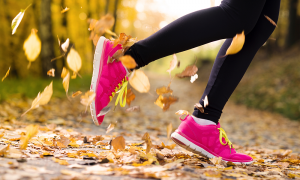Athletic Shoe 411 Study Shows Cushioned Running Shoes May Increase Injuries
A study confirms cushioned running shoes put more stress on a runner’s body and cause more injuries than minimalist running shoes.
A new study out of the University of Exeter may have the potential to forever change the running shoe industry. Its findings suggest that the cushioned running shoes athletes often choose to help reduce the risk of running injuries may actually put more stress on a runner’s body and cause more injuries than minimalist running shoes.
Why Minimalist Running Shoes Beat Cushioned Running Shoes
Researchers observed 29 runners in an attempt to compare how quickly the force acts when runners’ feet hit the ground (known as the loading rate). They found that the loading rates for those wearing “minimal running shoes” was much lower than those wearing regular running shoes, partially due to those in minimalist shoes landing on the ball of their foot rather than the heel when running.
“So many people use running as a means of reducing the risk of chronic diseases, but about three quarters of runners typically get injured in a year,” says Dr. Hannah Rice, lead author of the U of E study. “Footwear is easily modifiable but many runners are misguided when it comes to buying new running shoes. This research shows that running in minimal shoes and landing on the balls of your feet reduces loading rates and may therefore reduce the risk of injury."
Athletes who wear cushioned running shoes tend to land on their heels — known as a rearfoot strike — and they use the support of the shoe to assist them in their landing. Whereas runners who wear less cushioned running shoes tend to land on the ball of their foot — known as a forefoot strike — while running. The latter is thought to be much healthier for the runner.
READ MORE: Your Feet May Be To Blame For Your Sore Back And Knees
“Our research tells us that becoming accustomed to running with a forefoot strike in shoes that lack cushioning promotes a landing with the lowest loading rates, and this may be beneficial in reducing the risk of injury,” says Dr. Rice.
How To Make A Running Shoe Change
In order to avoid injuries, iIt’s important that runners who are used to traditional, cushioned running shoes don’t immediately switch out to minimalist running shoes. Any transition to new footwear, especially shoes that impact the foot strike pattern, should be undertaken gradually to avoid sudden changes and strain on your body.
For more information, check out our article on minimalist shoes.
Notice concerning medical entries:
Articles having medical content shall serve exclusively for the purpose of general information. Such articles are not suitable for any (self-) diagnosis and treatment of individual illnesses and medical indications. In particular, they cannot substitute for the examination, advice, or treatment by a licensed physician or pharmacist. No replies to any individual questions shall be effected through the articles.






